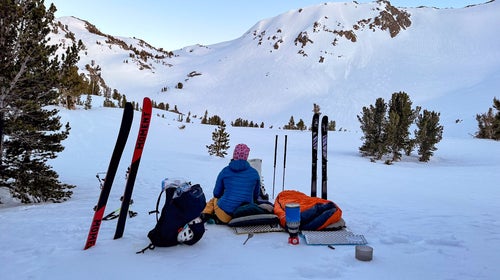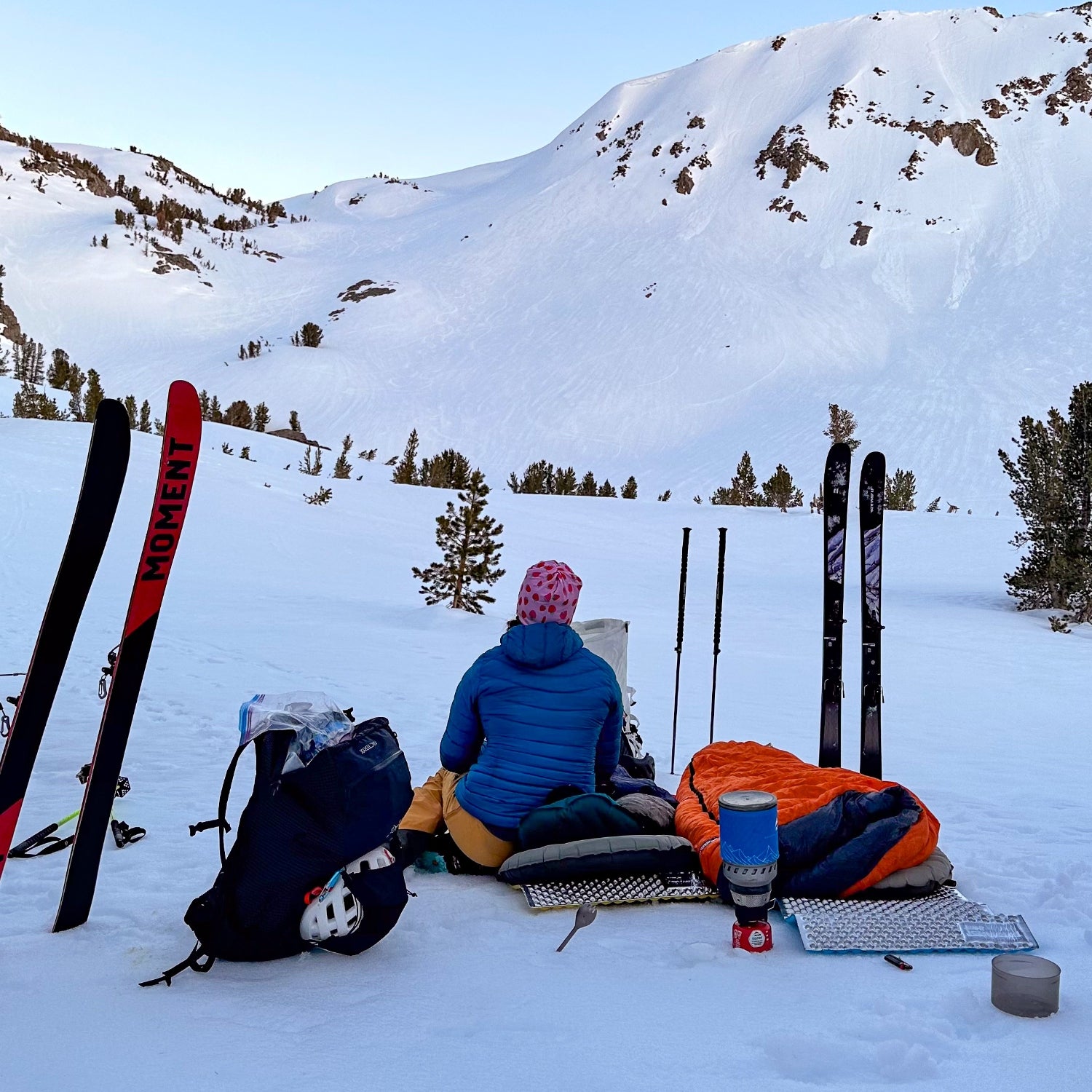I have often joked that skiing is a jealous lover. I spend all my money on her. When sheтАЩs around, all my free time is devoted to her, too. Friendships with people who don’t understand her appeal fall by the wayside тАФin a way, she isolates me. If IтАЩm up too late midweek, I still answer her call at 5:45 in the morning to walk a couple thousand feet uphill in the pre-dawn gloom to chase a little joy before I settle into my workday. God forbid I miss a day or a weekendтАФwho knows what conditions might have lined up unexpectedly? What sleeper pow day I could miss? Will my fitness falter, my flow grow clunky, uneven? No matter that I have skied dozens and dozens of days this year, if a late February storm hits and I miss it, I start to fear the relationship is falling apart. This isnтАЩt a casual relationship, and I often feel I have no choice but to be very committed. IтАЩm in lovejail with my favorite sport.
Complicating matters is the fact that access to skiing isnтАЩt just dictated by time and money. Skiers are also at the whims of the weather, which is increasingly fickle.
In an El Ni├▒o year, my home state, New Mexico, is supposed to fare well. We donтАЩt often have much luck when it comes to snowpack, with regards to depth or stability. But these years that skiers in the Pacific Northwest dread? This is our sweet spot. When we might get lucky, surpass 200 inches. At Taos, where I ski most often, the average snowfall in a season┬аis just 177 inches. But warmer temperatures on the surface of the central and eastern Pacific Ocean are supposed to send cooler, wetter weather our way, while the northern half of the continent deals with a warm, dry winter.
Last fall, everyone was buzzing about the upcoming winter. The last two La Ni├▒a winters had been slow to start, keeping us guessing until mid-February when the storms really started to stack up. In December and January, IтАЩd get antsy, existential. When winter finally came around, I was grateful and relieved, but also frazzled. It felt like the weather was playing hard to get, and when it finally came around, my trust had been so tested I could hardly enjoy it.
In November, the snow started falling, blanketing Santa Fe in early storms. I repeated myself to myself, to my friendsтАФI have high hopes and low expectations. If I donтАЩt dream too big, winter canтАЩt hurt my feelings too much. Right?
As it turns out, winter was bluffing. In December, the skies turned a relentless, untouchable blue. We got 21 inches of snow between December 4 and January 4тАФnowhere near enough to make TaosтАЩs rocky terrain skiable. We had a stormy week, then January dried up too. In early February, it looked like things were starting to turn on. Last year, we had a 222-inch snowfall, most of which came in February and March. Those pesky hopes reared their heads. But here we are, in early April, with just 65 inches┬аof snow on the ground.
I worked as a dishwasher at AltaтАЩs GoldminerтАЩs Daughter for a little while, when I was 23. I lived in employee housing in the basement of the lodge, along with most of my coworkers. The mood among AltaтАЩs seasonal population swung wildly between a deep conviction that we were living the dream and angsty cabin fever. When conditions were good, we would roll out of bed and line up for first chair ten minutes later. Life was about skiing and nothing else, and skiing was more than enough. But when high pressure set in for more than a few days, the energy shifted. WeтАЩd get antsy, unsure of what we were doing living at the end of a highway and washing dishes for tourists, all for the sake of skiing chattery hardpack in blown-out boots. People would drink, sulk, and wait for the next storm to fall and remind us that everything was alright. Until then, it was just us and the high-pressure blues.
These last few years, each winter has started off with this feeling. As fall wanes, the fish grow sluggish and the trails get icy, the forests go brown and we wait for the snow to settle upon us like a weighted blanket. Here in northern New Mexico, we feel that weightтАФor lack thereofтАФkeenly, knowing that wildfires will start burning as soon as March or April if we donтАЩt get enough snow to keep the forests wet through our windy spring. We know that the snowpack feeds the rivers in which we fish and swim, supports the watershed that supplies the city water. As the early weeks of winter drag on, with no snow in sight, I get that old cabin fever feeling. IтАЩm antsy to do the sport that I love. To build strength and fitness and relationships for the season ahead, to start dreaming about the lines we hope fill in come spring and the trips we want to take. But it is a small step from worrying about the season to worrying about the future of the sport. And a small step from there to worrying about the future of the ecosystems that depend on annual snowpack to survive.
I realized recently┬аthat these high-pressure, no-snow blues, are reminiscent of the feeling I get when I know I need to end a relationship. Like we are growing apart, and I can no longer count on this lover showing up for me in the way they used to. Maybe she doesnтАЩt make me feel the same way she did in years past.
Everyone loves to talk about when we talk about climate, but thatтАЩs because itтАЩs a rare instance in which we donтАЩt need to turn to another languageтАФGerman, DanishтАФto find a strange word that describes with uncanny precision exactly what weтАЩre feeling. ItтАЩs as if IтАЩm in preemptive mourning for a way of life┬аthat might not be feasible in another 50 years. IтАЩm grieving the assuredness that skiing was enough to stake a life on, at least for five or six months out of the year.
And still, this winter, I’ve been there in the liftline every weekend morning, aching shins pressed against my ski boots, hoping the weeks-old snow stayed chalky. During the work week, I fold my tired body into the driver’s seat of my truck at 6 A.M. to squeeze in a ski tour before work, even if IтАЩm just chasing fresh corduroy in-bounds before the lifts start spinning. IтАЩve poked around the backcountry, patiently digging pits, checking the snowpack, taking in the view, and skiing safe pockets of soft snow. Sometimes I wish I could just stop caring about skiing, do something else instead, something that doesnтАЩt rub my nose in everything IтАЩm afraid to lose. But even if the strange weather fills me with dread, IтАЩm a creature of habit, and this winter rhythmтАФwake up early, exhaust myself in the cold air, sleep deep, do it againтАФfeels like a heartbeat.
Some friends and I were recently discussing what month feels like the new year. For one academically inclined friend, it has always been September. For another, itтАЩs April, the beginning of spring. For me, October has always felt like the true marker, when the leaves fall and winter, my favorite season, begins to murmur in the high peaks. A few days later, I was researching some snowpack statistics and realized that thatтАЩs when the begins, when researchers start to calculate annual snowfall, can begin to predict how the rivers might run in the spring.
Snow is good technologyтАФbetter than any water storage system we humans have come up with. While reservoirs lose massive amounts of water to evaporation, snow deflects the sun and melts at the base of the snowpack, where water can move, protected, to the streams and rivers below. It doles out what we need over time, ensuring that we have water for the dry months in late summer. The snowpack feels almost intelligentтАФit has natural self-defense systems, and distributes┬аwater with careful portioning and forethought. ItтАЩs a nurturer. Life in the West depends on it. And even if skiing may be shallow ground on which to stake my life, snow itself is actually foundational.
When the leaves go golden in the fall, the trails grow crowded. Instead of being peeved at these fair-weather peepers, IтАЩve come to think of it like this: The mountain is throwing a dinner party. She set the table all nice. How sweet that everyone accepted her invitation. The pilgrimage up to the hills when the snow falls feels the same. ItтАЩs not her fault that this winter may be more famine than feast. Early this year, after one of the first storms, I ran into a friend near the top of our local hill. I had walked up on my touring setup for a single lap, he was on his way up for a third. тАЬHay que aprovecharse,тАЭ he told usтАФwe must take advantage, when the snow falls, no matter how it falls.
Skiing may be a jealous lover, and winter a heartbreaker, but snow is impossibly generous. And even if my heart keeps on breaking, the best way I know how to say thank you is to show up to the party, listen for that familiar rhythm, and dance.


